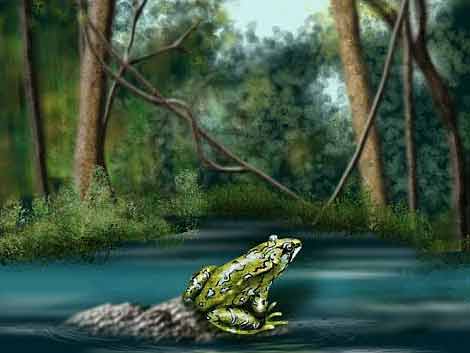青蛙对抗自然界的“杀手”
来源:《Nature》
作者:Taegan A. McMahon等
时间:2014-07-21

反复接触有害的真菌,可以帮助青蛙抵抗病原体感染
近几十年,两栖类在全球范围内出现了种群数量快速下降,主要元凶之一是两栖动物壶菌病。该病由真菌壶菌(chytrid fungus)引起,是一种新出现的急性的只感染两栖动物的致死性传染病,是目前全球两栖动物多样性的最大威胁。
但是7月10日Nature杂志上的一篇文章却表明,面对这种恶性杀手,动物也不是完全没有保护力,研究指出多次接触壶菌而幸免于难的青蛙会发展出一些重要的免疫力。
“我们的研究结果为保护两栖类和其他野生动物,如蝙蝠、 蜜蜂和蛇免受病原真菌的威胁,带来了新的希望,这些动物能获得抵抗真菌的抵抗力,并且我们通过基于群体免疫力的一些管理措施也能挽救这些物种”,文章作者之一,南佛罗里达大学的生物学家Jason Rohr表示。
壶菌病发现于1997年,主要侵染两栖动物变态后个体(即亚成体和性成熟个体)的角质化表皮及幼体的牙行和颚鞘,扰乱表皮的渗透调节功能,导致两栖动物由于个体的电解质不平衡而死亡。
全球已有50个国家超过500种两栖动物感染该病,其中有约100种两栖动物因感染该病而绝灭或可能绝灭,还有100多个种群正在快速下降。针对于这种情况,各国科学家们均展开了研究,此前的研究表明两栖动物无法获得对这种病原体的抵抗力。
但是最新研究通过对包括古巴树蛙在内的几种两栖类进行研究,发现青蛙能学会避开这种病原体,克服在反复接触蛙壶菌后由其所诱导产生的免疫抑制,并能利用死病原体获得对它的免疫力。
Rohr与他的同事让青蛙接触了活着的和已经死了的蛙壶菌(Batrachochytrium dendrobatidis,Bd),但是不控制这种感染。结果发现在这两种情况下,那些曾多次接触真菌的青蛙,要比从未接触过这种真菌的青蛙表现更好。这一结果表明,青蛙能发展出针对这种真菌的免疫力来,这也许有助于为动物进行免疫接种。
“这也许能为抵御这种致命感染提出一种新的方法”,科罗拉多大学博士后研究员Doug Woodhams(未参与该项研究)说。
研究人员目前已将受威胁的两栖类动物保护起来,避免它们受到蛙壶菌的影响,并在圈养条件下进行饲养,他们希望能通过疫苗诱导这些动物产生抵抗力,然后再放回自然界中。
但这种疫苗的可行性还存在一些疑问,因为免疫后五个月的动物死亡率达到80%。
“这已经是一个 Bd 的世界,”马里兰大学Karen Lips表示,“基本上所有的两栖类动物都已经受到了这种真菌的威胁,其中一些被再次感染,一些死了,一些还存活着。不过,任何表明两栖类能幸存下来的证据都是好消息,希望动物园和非政府组织 NGOs的相关举措也能保护这些种群的生存。” (引自:生物谷360)
Amphibians acquire resistance to live and dead fungus overcoming
fungal immunosuppression
Abstract Emerging fungal pathogens pose a greater threat to biodiversity than any other parasitic group1, causing declines of many taxa, including bats, corals, bees, snakes and amphibians. Currently, there is little evidence that wild animals can acquire resistance to these pathogens. Batrachochytrium dendrobatidis is a pathogenic fungus implicated in the recent global decline of amphibians. Here we demonstrate that three species of amphibians can acquire behavioural or immunological resistance to B. dendrobatidis. Frogs learned to avoid the fungus after just one B. dendrobatidis exposure and temperature-induced clearance. In subsequent experiments in which B. dendrobatidis avoidance was prevented, the number of previous exposures was a negative predictor of B. dendrobatidis burden on frogs and B. dendrobatidis-induced mortality, and was a positive predictor of lymphocyte abundance and proliferation. These results suggest that amphibians can acquire immunity to B. dendrobatidis that overcomes pathogen-induced immunosuppression and increases their survival. Importantly, exposure to dead fungus induced a similar magnitude of acquired resistance as exposure to live fungus. Exposure of frogs to B. dendrobatidis antigens might offer a practical way to protect pathogen-naive amphibians and facilitate the reintroduction of amphibians to locations in the wild where B. dendrobatidis persists. Moreover, given the conserved nature of vertebrate immune responses to fungi and the fact that many animals are capable of learning to avoid natural enemies, these results offer hope that other wild animal taxa threatened by invasive fungi might be rescued by management approaches based on herd immunity.
原文链接:http://www.nature.com/nature/journal/v511/n7508/full/nature13491.html




